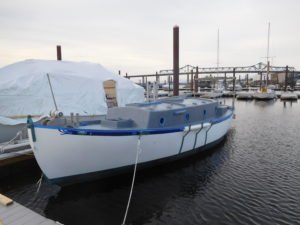
There was a delay of some weeks in working further on the dinghy, since Ganymede needed to be finished and got out of the marina by a certain date. It was a desperate time, with Danielle and the girls going out and sanding whenever the weather allowed, then me sanding some more after work, then scraping on a bit of filler to sand off again next day. She needed two coats of primer before the four-stage process of topcoat, and of course all the best hours of the day were taken up with working at my full-time job or tending the side business of rigging.

But you’re probably wondering what the four-stage topcoat process involves. It is simply this: first, the areas to receive nonskid must be taped off neatly. Then, a coat of paint is rolled onto just those areas. While it’s still very wet, you sprinkle dry nonskid dust (in this case Griptex, the Awlgrip brand nonskid) onto it. Next day, whatever dust didn’t soak in gets vacuumed off, then the process is repeated. Usually two thorough sprinkles is enough to get a nice even bed of nonskid down.

Now the masking tape can be removed, and the areas not receiving any paint at all masked off; last of all, two final coats go over all areas. This ensures that there will be no ugly tape lines between the nonskid and the smooth spots, and leaves a really nice finish with extra coats over the high-wear areas.
If you’ve done any amount of painting, you’ll know that the very worst time to apply shiny topcoat is outdoors on a windy day with dusk falling and a good chance of dew later. But we were lucky. Not only did we have all of those setbacks, but another that even the most pessimistic painter could not have foreseen: the gypsy moths were hatching, and thousands of tiny gray worms were airborne, dangling by transparent threads of gossamer. Almost all of them found their way to Ganymede’s fresh paint and settled there like sprinkles on an ice cream sundae. What to do? I couldn’t pick each one out individually, so I just rolled paint right over them all, and was thankful that they were still small.

After all’s said and done, Ganymede doesn’t look too terrible, if you look at her only on a windy day with dusk falling, and her nonskid is a delight to walk on: nice and grippy, but not so harsh as to damage ropes. The paint was still quite soft, and her sheer stripe barely dry, when we left the marina with the mast newly stepped, none of the shrouds tuned, and not a single halyard rove. I hadn’t even bolted the wooden bulwarks back on, and they were just lying on deck all a-hoo, as the saying goes. But the important thing is that she has a new cockpit and fresh paint and was out of the marina before her welcome wore out.
The rest of her—putting on winches and compass and bolting on hardware and rigging her up will be finished up while she dances to her mooring bridle. Not so convenient as being dockside, since everything must go back and forth by dinghy, and the alert reader will no doubt remember that Woggs, our primary dinghy, is not done yet. For the interim, we’re using an old beater I used to use as a commuter while we were still living aboard. Every perilous trip I make out to Ganymede in her (she’s not a cargo dinghy), makes me more determined to crack down on Woggs and get her ready to go.